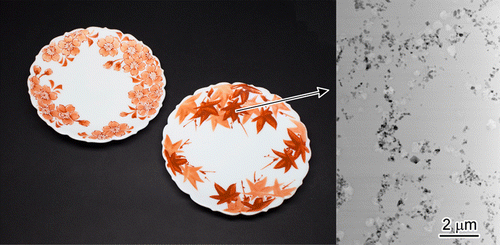The art—and science—behind treasured Japanese porcelain

Porcelain connoisseurs have prized the traditional Japanese-style ceramics called akae, typically known for Kakiemon-style ware, for centuries. Its paintings feature a vivid red color against a milky white background. Artisans have passed on their techniques to produce this type of porcelain for generations, but these methods are poorly documented. Now scientists report in the journal ACS Applied Materials & Interfaces a practical method for preparing red paints for high-quality akae.
Since the early 17th century, master potters have honed their techniques for creating akae ceramics by trial and error, and then passed on their methods to their apprentices. The quality of the resulting porcelain varies, however. In a search for a more reliable way to make superior akae, a few studies have probed the underlying structure that makes the best red ceramics. But they didn't clarify the essential coloring mechanism. Hideki Hashimoto and colleagues wanted to gain a deeper understanding of what makes the most distinctive akae.
The researchers experimented with different methods for making red coloring with hematite and a lead-free glass frit, a ground material used to make glazes and glass. They found that the sizes of hematite particles and of the frit powder played an important role in color quality. Based on their results, the researchers developed a simple process for preparing red paints for creating exceptional akae. It involves mixing hematite, frit powder and a solvent three times with a mortar and pestle, instruments commonly used by porcelain artisans. Because the method is simple, the researchers say today's potters could easily adopt it.
More information: Hideki Hashimoto et al. Controlling the Color of Lead-Free Red Overglaze Enamels and a Process for Preparing High-Quality Red Paints, ACS Applied Materials & Interfaces (2016). DOI: 10.1021/acsami.6b01549
Abstract
Akae porcelain, an artistic Japanese traditional overglaze ceramic typically known for Kakiemon-style ware, has fascinated porcelain lovers around the world for over 400 years because of the graceful red color displayed by akae that matches so well with white porcelain bodies. In this work, we clarified the factors that control the color of akae and those that are conventionally controlled by artisans based on empirical experience. Inspired by a recent particle-design method, we also developed a practical facile process to prepare red paints that yields high-quality akae. Various akae samples were prepared from a combination of lead-free alkali borosilicate glass frits with different particle sizes and hematite powders with differing dispersibilities. Polarized light microscopy, scanning electron microscopy, and transmission electron microscopy analyses indicate that considering only the dispersibility of hematite powders is not sufficient, but the frit-particle size must be controlled to obtain high-quality akae with a high reflectance value for ≥580 nm visible light. In addition, we developed a process for preparing high-quality red paints that uses a large-particle frit powder and a strongly aggregated-hematite powder, both of which are easily obtainable. The red paint composed of frit, hematite, and the solvent is mixed until the paint is drying. By adding more solvent and repeating this process three times, we obtained high-quality akae with a higher reflectance value than for the akae prepared from a frit with submicron-sized particles and weakly aggregated-hematite powder. On the basis of transmission electron microscopic observations, we consider the red paint to consist of a core/shell-like composite structure of frit and hematite, forming a three-dimensional network in the akae glass layer. The good dispersibility of these particles leads to high-quality akae.
Journal information: ACS Applied Materials and Interfaces
Provided by American Chemical Society



















